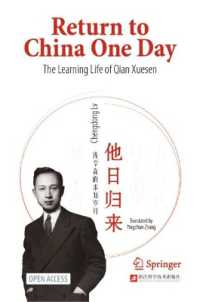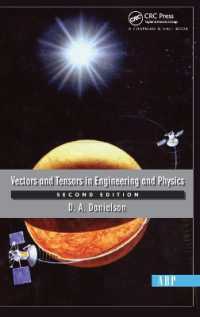基本説明
Breaks new ground with a discussion of multicultural factors related to physical activity promotion and intervention.
Full Description
Based on the 10th Measurement and Evaluation Symposium, "Measurement Issues and Challenges in Aging Research," Measurement Issues in Aging and Physical Activity considers research from experts around the world relating to the latest questions, challenges, and techniques in aging and measurement. The reference addresses a range of topics in aging research, including issues from the fields of kinesiology, biology, physiology, technology, urban planning, measurement, and statistics.
Measurement Issues in Aging and Physical Activity breaks new ground with a discussion of multicultural factors related to physical activity promotion and intervention. Ideas include using culture as a catalyst for active living and using culture-based physical activity as an alternative approach to promotion of active living. The reference further examines multicultural issues with a look at alternative medicine, including an account of a demonstration of qi-gong, a traditional Chinese exercise, from the symposium.
-Measurement Issues in Aging and Physical Activity also provides information on
the benefits of and barriers to exercise in older adults;
-interventions to improve quality of life in older adults;
-advanced statistical methodologies, with discussion of structural equation modeling and longitudinal data analysis; and
-issues regarding training of future aging research and measurement specialists.
In addition, a new term, kinesmetrics, is introduced for the field of measurement and evaluation. Kinesmetrics is defined as a discipline for developing and applying measurement theory, statistics, and mathematical analysis to the field of kinesiology.
The groundbreaking Measurement Issues in Aging and Physical Activity explores subjects in a range of research topics. For both veterans and newcomers to the field, this reference will be a comprehensive guide to the latest research on aging in measurement and physical activity.
The 10th Measurement and Evaluation Symposium was supported by the American Association for Active Lifestyle and Fitness (AAALF), the American College of Sports Medicine (ACSM), the Measurement and Evaluation Council, the University of Illinois at Urbana-Champaign, and Human Kinetics.
Contents
Part I: Critical Issues in Aging and Physical Activity Research
Chapter 1. Human Gene Map, Physical Activity, and Aging
Tuomo Rankinen, PhD
-Genetics and Health-Related Fitness
-Genetic Research Approaches: Candidate Genes Versus Genomic Linkage Scans
-Genetics, Aging, and Health-Related Fitness
-Summary and Conclusions
Chapter 2. Physical Activity and Older Adults: Impact on Physical Frailty and Disability
Miriam E. Nelson, PhD, FACSM, and Rebecca Seguin, MS, CSCS
-Overview of the Health Benefits of Exercise and Older Adults
-Initial Strength Training Research With Older Adults
-Frailty and Falls
-Bone and Joint Health
-Endurance
-Strength and Functional Performance
-A Variety of Strength Training Prescriptions
-The Potential of Power Training
-Conclusion
Chapter 3. Exercise Dose-Response Effects in Older Adults
Roy J. Shephard
-Relative Versus Absolute Intensity of Effort
-Experimental Evidence
-Some Problems of Research Design
-Is Aerobic Fitness Enough?
-Moderate or Intense Physical Activity: A Public Policy Debate
-Consensus Recommendations
-Systematic Review of Dose-Response Issues
-All-Cause and Cardiovascular Mortality
-Research Priorities
Chapter 4. Control and Regulation of Movement in Elderly Adults
Caroline J. Ketcham and George E. Stelmach
-Movement Characteristics
-Coordination
-Skill Learning
-Visual Monitoring
-Concluding Remarks
Chapter 5. Environment, Culture, and Physical Activity of Older Persons
Uriel Cohen, Darch, and Ruth Cohen, PhD
-Culture: A Working Definition
-Active Living: A Working Definition
-Benefits of Active Living: Contributions to Physical and Mental Health
-The Problem: Barriers to Active Living
-The Premise: Cultural Heritage As a Catalyst for Active Living
-The Context of the Case Study: History, Culture, Demographics, and Economy
-Conclusions
Part II: Measurement Challenges in Aging Research
Chapter 6. Physical Activity, Aging, and Quality of Life: Implications for Measurement
Edward McAuley and Steriani Elavsky
-Conceptualizing and Defining Quality of Life
-Measuring Quality of Life in Physical Activity Research
-Can Physical Activity Improve Quality of Life in Older Adults?
-Can Physical Activity Improve Quality of Life in Cancer Patients?
-Is There a Dose-Response Relationship for Physical Activity Effects on Quality of Life?
-Issues to Consider in the Physical Activity and Quality of Life Relationship
-Concluding Remarks
Chapter 7. Assessment Issues Related to Physical Activity and Disability
James H. Rimmer, PhD
-Defining Disability
-Importance of Physical Activity in Improving Function
-Impact of the Environment on Health and Wellness
-Measurement Issues in Disability and Physical Activity
-Conclusion
Chapter 8. Measuring the Ever-Changing "Environments" for Physical Activity in Older Adults
James R. Morrow, Jr., PhD, and Dale P. Mood, PhD
-Measurement Issues
-Statistical Analysis
-Sample Instrumentation Issues
-The Challenge
-Future Research
Chapter 9. Translating Research to Practice: Real-World Evaluation and Measurement Issues in Moving From Efficacy to Effectiveness Research
Marcia Ory, PhD, MPH; Diane Dowdy, PhD; Brigid Sanner; Robin Mockenhaupt, PhD, MPH; Laura Leviton, PhD; Russell Glasgow, PhD; Abby King, PhD; Cynthia Castro, PhD; Michele Guerra, MS, CHES; and Sara Wilcox, PhD
-The Evolving Research Base
-Principles of Behavior Change Research
-Behavioral Change Consortium
-Key Measurement/Methods Questions
-Furthering Translational Research
Chapter 10. Qi, Aging, and Measurement: History, Mystery, and Controversy
Weimo Zhu, PhD
-What Are Qi and Qi-Gong?
-A Brief History of Qi-Gong
-Qi-Gong and the World
-Qi-Gong Schools and Classification
-Mystery and Controversy Surrounding Qi-Gong
-Qi-Gong and Health
-Qi-Gong and Aging
-Qi Measurements and Challenges
-Future Research Directions
Part III: New Measurement Methods and Techniques
Chapter 11. Common Shape Models for Trend Curves
Roderick P. McDonald
-Common Shape Models
-Conclusions
Chapter 12. Emergent Technologies and Remote Clinical Assessment
Leigh W. Jerome
Part IV: Measurement in Kinesiology: Past, Present, and Future
Chapter 13. Measurement and Evaluation Council: Past, Present, and Future
Ted A. Baumgartner
-Structure
-Past
-Present
-Future
Chapter 14. The Changing Face of the Measurement Specialist in Kinesiology
Stephen Silverman
-Coming Clean
-Changes in the Measurement and Evaluation Field
-Issues and Questions for the Future
-Conclusion
Appendix: Program of the 10th Measurement and Evaluation Symposium
References
About the Editors








